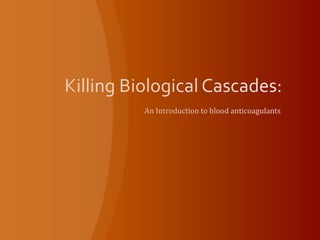
Killing biological cascades
- 1. Killing Biological Cascades: An Introduction to blood anticoagulants
- 2. Contents Biological Cascades Recap – Blood Clotting Mechanism Vitamin K – How it contributes Anticoagulants? Coumarins – Mechanism Heparin Derivatives – Mechanism So…are they different?
- 3. Cascades Consider the chemical reactions below A+ B X A+ C D D + E F F + G H B + H X
- 4. -Why you don’t bleed to death- When wound occurs: Platelets adhere to collagen fibers and release clotting factors, starting the clotting mechanism.
- 7. 2-methyl-1,4-naphthoquinone (ZOMGWTFBBQUBER1337HAX?!) A.K.A Vitamin K. undergoes reduction to a reduced form of vitamin K via enzyme EpoxideReductase. (VKOR) Reduced Vitamin K is then used to carboxylateGlu residues to Gla residues in various coagulation factors to activate them. Associated carboxylation enzyme turns Vitamin K to its oxidised state, which is then reduced by EpoxideReductase. Cycle continues.
- 8. Anticoagulants in a nutshell Substance that stops blood from clotting ( A.K.A it interferes with the clotting cascade somehow) Used primarily to prevent inappropriate blood clotting ( Eg: Pulmonary Embolism , Stroke, Myocardial Infarctions) We will be looking at 2 types of anticoagulants today, using the examples: Coumarins (Warfarin) Heparin & Derivatives ( Heparin)
- 10. Prevents activation of coagulation factors via carboxylation
- 11. Coagulation factors cannot bind in a stable manner to wound
- 12. Cannot activate clotting to allow formation of a clot
- 13. Blood doesn’t clot.Because it is an competitive inhibitor, effects can be undone through providing high concentrations of Vitamin K. Vitamin K is an antidote to Warfarin Poisoning.
- 15. AT inactivates thrombin (electrostatic attraction) and factor Xa (changing active site conformation)
- 17. Conclusion Random Facts Due to the complimentary actions of both drugs, they are often taken together, with heparin stopped after a day or two. Fast action of heparin also means that it is used in various healthcare machines (Dialysis Machines, CPB pumps) to prevent clots forming in the tubes. choice of which anticoagulant to use will depend on the condition being treated as well as how the body reacts to the medication.
- 18. Questions?
- 20. SO…. Try Warfarin today! If it can kill rats, It definitely can kill you! This advertisement is of courtesy to our sponsor - Wilson Pharmaceuticals Pte Ltd
- 21. Thank You. -End the d**n thing lar. So boring can?-
